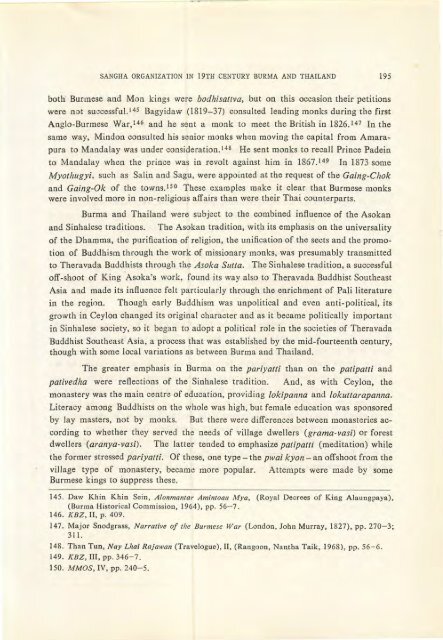The Journal of the Siam Society Vol. LXXII, Part 1-2, 1984 - Khamkoo
The Journal of the Siam Society Vol. LXXII, Part 1-2, 1984 - Khamkoo
The Journal of the Siam Society Vol. LXXII, Part 1-2, 1984 - Khamkoo
You also want an ePaper? Increase the reach of your titles
YUMPU automatically turns print PDFs into web optimized ePapers that Google loves.
SANGHA ORGANIZATION IN 19TH CENTURY BURMA AND THAILAND 195<br />
both- Burmese and Mon kings were bodhisattva, but on this occasion <strong>the</strong>ir petitions<br />
were not successful.l 45 Bagyidaw (1819-37) consulted leading monks during <strong>the</strong> first<br />
Anglo-Burmese War,146 and he sent a monk to meet <strong>the</strong> British in 1826.147 In <strong>the</strong><br />
same way, Mindon consulted his senior monks when moving <strong>the</strong> capital from Amarapura<br />
to Mandalay was under consideration.l 48 He sent monks to recall Prince Padein<br />
to Mandalay when <strong>the</strong> prince was in revolt against him in 1867.149 In 1873 some<br />
Myothugyi, such as Salin and Sagu, were appointed at <strong>the</strong> request <strong>of</strong> <strong>the</strong> Gaing-Chok<br />
and Gaing-Ok <strong>of</strong> <strong>the</strong> towns.1 50 <strong>The</strong>se examples make it clear that Burmese monks<br />
were involved more in non-religious affairs than were <strong>the</strong>ir Thai counterparts.<br />
Burma and Thailand were subject to <strong>the</strong> combined influence <strong>of</strong> <strong>the</strong> Asokan<br />
and Sinhalese traditions.<br />
<strong>The</strong> Asokan tradition, with its emphasis on <strong>the</strong> universality<br />
<strong>of</strong> <strong>the</strong> Dhaq1ma, <strong>the</strong> purification <strong>of</strong> religion, <strong>the</strong> unification <strong>of</strong> <strong>the</strong> sects and <strong>the</strong> promotion<br />
<strong>of</strong> Buddhism through <strong>the</strong> work <strong>of</strong> missionary monks, was presumably transmitted<br />
to <strong>The</strong>ravada Buddhists through <strong>the</strong> Asoka Sutta. <strong>The</strong> Sinhalese tradition, a successful<br />
<strong>of</strong>f-shoot <strong>of</strong> King Asoka's work, found its way also to <strong>The</strong>ravada Buddhist Sou<strong>the</strong>ast<br />
Asia and made its influence felt particularly through <strong>the</strong> enrichment <strong>of</strong> Pali literature<br />
in <strong>the</strong> region. Though early Buddhism was unpolitical and even anti-political, its<br />
growth in Ceylon changed its original character and as it became politically important<br />
in Sinhalese society, so it began to adopt a political role in <strong>the</strong> societies <strong>of</strong> <strong>The</strong>ravada<br />
Buddhist Sou<strong>the</strong>ast Asia, a process that was established by <strong>the</strong> mid-fourteenth century,<br />
though with some local variations as between Burma and Thailand.<br />
<strong>The</strong> greater emphasis in Burma on <strong>the</strong> pariyatti than on <strong>the</strong> patipatti and<br />
pativedha were reflections <strong>of</strong> <strong>the</strong> Sinhalese tradition. And, as with Ceylon, <strong>the</strong><br />
monastery was <strong>the</strong> main centre <strong>of</strong> education, providing lokipanna and lokuttarapanna.<br />
Literacy among Buddhists on <strong>the</strong> whole was high, but female education was sponsored<br />
by lay masters, not by monks. But <strong>the</strong>re were differences between monasteries according<br />
to whe<strong>the</strong>r <strong>the</strong>y served <strong>the</strong> needs <strong>of</strong> village dwellers (grama-vasi) or forest<br />
dwellers (aranya-v(lsi). <strong>The</strong> latter tended to emphasize patipatti (meditation) while<br />
<strong>the</strong> former stressed pariyatti. Of <strong>the</strong>se, one type - <strong>the</strong> pwai kyon- an <strong>of</strong>fshoot from <strong>the</strong><br />
village type <strong>of</strong> monastery, became more popular. Attempts were made by some<br />
Burmese kings to suppress <strong>the</strong>se.<br />
145. Daw Khin Khin Sein, Alonmantar Amintoau Mya, (Royal Decrees <strong>of</strong> King Alaungpaya),<br />
(Burma Historical Commission, 1964), pp. 56-7.<br />
146. KBZ, II, p. 409.<br />
147. Major Snodgrass, Narrative <strong>of</strong> <strong>the</strong> Burmese War (London, John Murray, 1827), pp. 270-3;<br />
311.<br />
148. Than Tun, Nay Lhai Rajawan (Travelogue), II, (Rangoon, Nantha Taik, 1968), pp. 56-6.<br />
149. KBZ, IH, pp. 346-7.<br />
150. MMOS, IV, pp. 240-5.

















